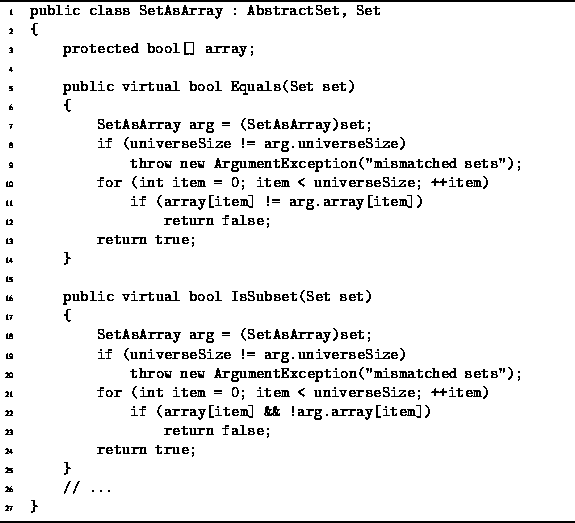|
Data Structures and Algorithms
with Object-Oriented Design Patterns in C# |
There is a special family of operators for comparing sets.
Consider two sets, say S and T.
We say that S is a subset of T,
written ![]() ,
if every element of S is also an element of T.
If there is at least one element of T that is not also an element of S,
we say that S is a
proper subset of T,
written
,
if every element of S is also an element of T.
If there is at least one element of T that is not also an element of S,
we say that S is a
proper subset of T,
written ![]() .
We can also reverse the order in which the expressions are written
to get
.
We can also reverse the order in which the expressions are written
to get ![]() or
or ![]() ,
which indicates that T is a
(proper) superset
of S.
,
which indicates that T is a
(proper) superset
of S.
The set comparison operators follow the rule that if ![]() and
and ![]() then
then ![]() ,
which is analogous to a similar property of numbers:
,
which is analogous to a similar property of numbers:
![]() .
However, set comparison is unlike numeric comparison in that there
exist sets S and T for which neither
.
However, set comparison is unlike numeric comparison in that there
exist sets S and T for which neither ![]() nor
nor ![]() !
For example, clearly this is the case for
!
For example, clearly this is the case for ![]() and
and ![]() .
Mathematically, the relation
.
Mathematically, the relation ![]() is called
a partial order
because there exist some pairs of sets for which neither
is called
a partial order
because there exist some pairs of sets for which neither ![]() nor
nor ![]() holds;
whereas the relation
holds;
whereas the relation ![]() (among integers, say) is a total order.
(among integers, say) is a total order.
Program ![]() defines the methods Equals and IsSubset
each of which take argument that is assumed to be a SetAsArray instance.
The former tests for equality
and the latter determines whether the relation
defines the methods Equals and IsSubset
each of which take argument that is assumed to be a SetAsArray instance.
The former tests for equality
and the latter determines whether the relation ![]() holds
between this and set.
Both operators return a bool result.
The worst-case running time of each of these operations is clearly O(N).
holds
between this and set.
Both operators return a bool result.
The worst-case running time of each of these operations is clearly O(N).

Program: SetAsArray class Equals and IsSubset methods.
A complete repertoire of comparison methods would also include
methods to compute ![]() ,
, ![]() ,
, ![]() , and
, and ![]() .
These operations follow directly from the implementation
shown in Program
.
These operations follow directly from the implementation
shown in Program ![]() (Exercise
(Exercise ![]() ).
).